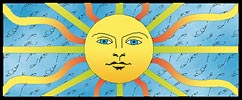
THE SUN / THE SUN
Innocent beauty, triumphant force.
HAPPINESS, ACHIEVEMENT, GLORY

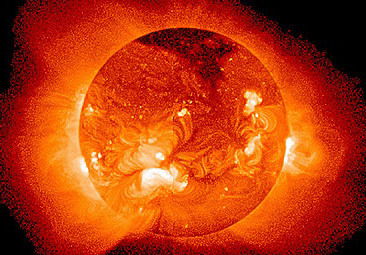
The Sun
The Sun's placement at birth sets the character for the person's spirit, for their basic drives and will.
For convenience, we refer to people by what sign their sun is in at birth, but this is really incomplete. The sun sets the general tone of who the person is, but placements of the other planets introduce traits far beyond the basic sun-stamp.
The Sun sign is the native's general approach to life, the basic attitude and way of behaving. Choices made, interests, motivations, and style are shown by the sun's placement at birth. Your ideal, unmasked self is your "Sun-Self" - who you are when you are most comfortable, and unguarded. The other planets do the guarding, the diplomacy, the doubting, or the inhibiting.
The Sun-Self is the part of your personality that differentiates itself from the rest of the world. The part of you that makes you distinctly you, even if it's your tendency to lose yourself in others. A Pisces sun for example, or as we would say "a Pisces" is apt to soften the lines between people, and not be a big individualist, like an Aries would be, for example.
About Our Sun:
Diameter: 1, 392, 000 km, or 109 times the diameter of the Earth and 9.75 times the diameter of Jupiter. Rotation Period at Equator: 24.6 days, Surface Temperature: 5 500�C Core Temperature: 15 million �C.
Volume: 1.3 million times the volume of the Earth
Sunspots and Solar Flares
The average number of visible sunspots varies over time, increasing and decreasing on a regular cycle of between 9.5 to 11 years, on average about 10.8 years. An amateur astronomer, Heinrich Schwabe, was the first to note this cycle in 1843. The part of the cycle with low sunspot activity is referred to as "solar minimum," the portion with high activity is known as "solar maximum." The year 2000, it is believed, was the solar maximum for the current solar cycle, though intense activity was observed in 2002.

The images below were taken in the fall of 2002 by a new Swedish telescope on the Canary Island of La Palma, one of the best places on Earth to view the sun.
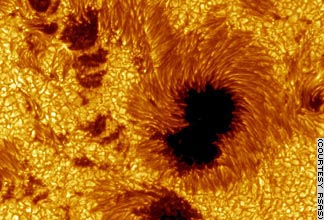
THE SOLAR FRACTAL
The Atlantic Ocean observatory documented previously unknown features: thin, dark cores within the bright filaments that encircle sunspots, which are intense magnetic storms that erupt like dark blemishes on the solar surface.
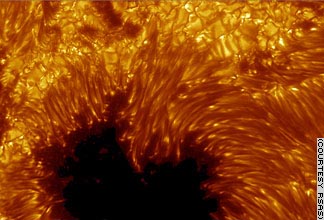
The one meter telescope produces images 1,200 times better than the best human eyesight. Each tendril of fire is thousands of miles thick, tens of thousands of miles long. The cooler, black areas, are wider than the diameter of the Earth.
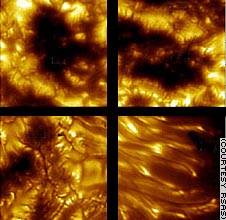
Relative to the size of the sun, the sunspots are no more that specks on its surface, hints of the titanic processes churning within the star.
Coronal mass ejections (CMEs) and emissions of high-energy solar flares become more common and more intense during the period of solar maximum. This increase in solar activity can affect us here on earth (and in earth's orbit) by what is known as space weather.
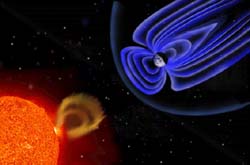
Ordinarily, the earth's own magnetic field protects it from most of the sun's emissions. But during periods of intense solar activity geomagnetic storms can produce heightened, spectacular displays of the Aurora Borealis and Aurora Australis, known as the Northern and Southern Lights. Geomagnetic storms can also disrupt radio transmissions and affect power grids.

Solar flares are tremendous explosions on the surface of the Sun. In a matter of just a few minutes they heat material to many millions of degrees and release as much energy as a billion megatons of TNT. They occur near sunspots, usually along the dividing line (neutral line) between areas of oppositely directed magnetic fields.
Flares release energy in many forms - electro-magnetic (Gamma rays and X-rays), energetic particles (protons and electrons), and mass flows. The flares extend hundreds of thousands of miles out from the sun, moving at high speed, with effects noticible here on Earth, 93 million miles away. Some flares can be dangerous to astronauts, who are beyond the protective magnetic field and atmosphere of the Earth.
The Sun is Exalted in Aries, and Rules Leo. The Sun's detriment is Aquarius, and its fall is Libra.
The Sepher associated with the Sun is Tipharet.
The Sun is the German Wotan, the Egyptian Ra, and the Greek Phoebus Apollo.